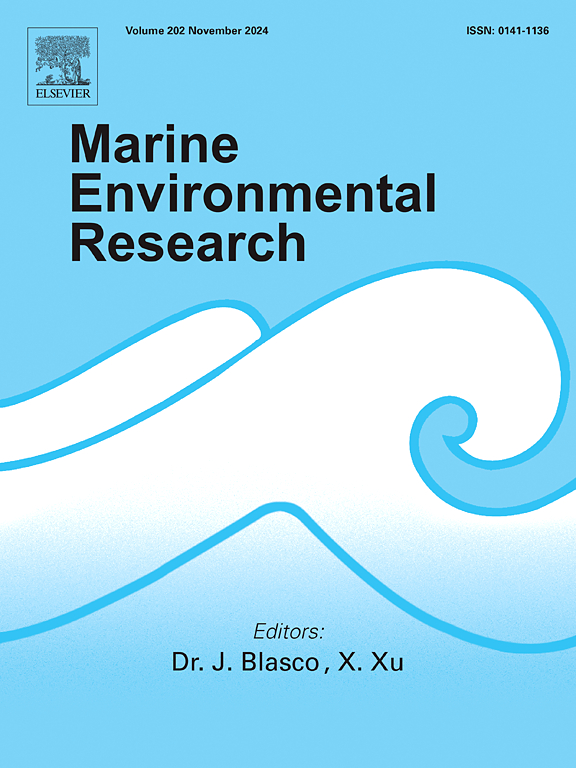Chatting behind the reef: Fish bioacoustic diversity of tropical back-reefs in Fiji, South Pacific
IF 3
3区 环境科学与生态学
Q2 ENVIRONMENTAL SCIENCES
引用次数: 0
Abstract
Back-reef habitats are important and fragile transition zones acting as nurseries for many coral reef fishes. In this framework, Passive Acoustic Monitoring (PAM) can be an important tool to evaluate the diversity and dynamics of sonic fish community. Here, we investigated the diversity, spatial and diel dynamics of fish sounds in back-reef habitats at Makogai Island in Fiji, South Pacific. Synchronized underwater recorders were deployed in 4 bays collecting data for about 4 days. The abundance of 12 different sub-categories of fish sounds were quantified. Signals were acoustically characterized and the level of discrimination between the sub-categories was evaluated by Discrimination Function Analysis. Generalized Additive Models showed that the abundance of signals was related to the bay and the hour. Moreover, the Shannon Diversity and Equitability Indices were calculated using acoustic and visual census data to describe fish biodiversity of each bay. The two bays with greater biodiversity based on visual census also showed a greater acoustic diversity at dawn and night. Our results highlight the importance of PAM to reveal the diversity of fish community in back-reef habitats, providing a baseline to understand future changes in these crucial environments.
在珊瑚礁后面聊天:南太平洋斐济热带后礁的鱼类生物声学多样性。
后礁栖息地是重要而脆弱的过渡区,是许多珊瑚礁鱼类的育苗地。在此框架下,被动声学监测(PAM)是评估声波鱼类群落多样性和动态的重要工具。在此,我们研究了南太平洋斐济马科盖岛后礁栖息地鱼类声音的多样性、空间和日间动态。我们在 4 个海湾部署了同步水下记录器,收集了约 4 天的数据。对 12 种不同的鱼类声音进行了量化。对信号进行了声学特征描述,并通过辨别功能分析评估了子类别之间的辨别水平。广义加法模型显示,信号的丰富程度与海湾和时间有关。此外,还利用声学和视觉普查数据计算了香农多样性指数和均等指数,以描述每个海湾的鱼类生物多样性。根据目测普查,生物多样性较高的两个海湾在黎明和夜间的声学多样性也较高。我们的研究结果突显了声学和海洋学模拟对揭示后礁栖息地鱼类群落多样性的重要性,为了解这些重要环境的未来变化提供了基线。
本文章由计算机程序翻译,如有差异,请以英文原文为准。
求助全文
约1分钟内获得全文
求助全文
来源期刊

Marine environmental research
环境科学-毒理学
CiteScore
5.90
自引率
3.00%
发文量
217
审稿时长
46 days
期刊介绍:
Marine Environmental Research publishes original research papers on chemical, physical, and biological interactions in the oceans and coastal waters. The journal serves as a forum for new information on biology, chemistry, and toxicology and syntheses that advance understanding of marine environmental processes.
Submission of multidisciplinary studies is encouraged. Studies that utilize experimental approaches to clarify the roles of anthropogenic and natural causes of changes in marine ecosystems are especially welcome, as are those studies that represent new developments of a theoretical or conceptual aspect of marine science. All papers published in this journal are reviewed by qualified peers prior to acceptance and publication. Examples of topics considered to be appropriate for the journal include, but are not limited to, the following:
– The extent, persistence, and consequences of change and the recovery from such change in natural marine systems
– The biochemical, physiological, and ecological consequences of contaminants to marine organisms and ecosystems
– The biogeochemistry of naturally occurring and anthropogenic substances
– Models that describe and predict the above processes
– Monitoring studies, to the extent that their results provide new information on functional processes
– Methodological papers describing improved quantitative techniques for the marine sciences.
 求助内容:
求助内容: 应助结果提醒方式:
应助结果提醒方式:


